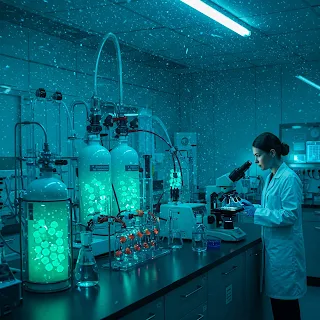Hydrogen is widely regarded as the fuel of the future, with its potential to revolutionize clean energy and significantly reduce carbon emissions. However, traditional hydrogen production methods rely heavily on fossil fuels, making them unsustainable and environmentally damaging. To address this challenge, scientists have been exploring innovative catalysts that can enhance hydrogen production while minimizing environmental impact.
One of the most promising advancements in this field is the development of Ruthenium-based catalysts. This article delves into the significance of Ruthenium in hydrogen production, recent research breakthroughs, and how this catalyst is shaping the future of clean energy.
Why Hydrogen? The Need for a Sustainable Energy
Source
Hydrogen is an efficient, clean-burning fuel that produces only water as a byproduct when used in fuel cells. It holds the potential to power everything from vehicles to industries while helping combat climate change. However, there are several challenges to widespread hydrogen adoption:
1. Current Hydrogen Production Methods Are Unsustainable
Most of the world's hydrogen is produced through steam methane reforming (SMR), which relies on natural gas and emits large amounts of carbon dioxide. Alternative methods, such as electrolysis powered by renewable energy, remain expensive and inefficient.
2. The Role of Catalysts in Hydrogen Production
Efficient hydrogen production requires catalysts to speed up chemical reactions while minimizing energy consumption. Platinum has been a popular choice, but it is costly and not widely available. This has led researchers to explore alternative catalysts, such as Ruthenium.
What is Ruthenium and Why is It Important?
Ruthenium (Ru) is a scarce transition metal and a member of the platinum group. Its distinct properties make it exceptionally valuable in catalytic applications, enabling efficient and versatile chemical reactions.
High catalytic activity: Speeds up hydrogen production reactions.
Lower cost than platinum: Offers an economically viable alternative.
Excellent stability: Can withstand harsh reaction conditions.
Versatility: Can be used in various forms, including nanoparticles, complexes, and alloys.
Ruthenium Catalysts in Hydrogen Production: The Science Behind It
Researchers have been exploring Ruthenium-based catalysts to enhance hydrogen production efficiency, especially in water splitting (electrolysis) and photocatalysis.
1. Ruthenium for Electrochemical Water Splitting
Water electrolysis is one of the cleanest methods for producing hydrogen. It involves splitting water (H₂O) into hydrogen (H₂) and oxygen (O₂) using an electrical current. Ruthenium-based catalysts improve this process by:
Enhancing Oxygen Evolution Reaction (OER): The slow OER is often the bottleneck in electrolysis. Ruthenium catalysts significantly reduce energy consumption and speed up the reaction.
Boosting Hydrogen Evolution Reaction (HER): HER efficiency is critical for hydrogen production, and Ruthenium-based catalysts demonstrate superior HER performance, comparable to platinum.
2. Photocatalytic Water Splitting with Ruthenium
Photocatalysis involves using light energy to drive chemical reactions. Ruthenium-based catalysts have shown great potential in solar-powered hydrogen production, making the process even more sustainable. Key benefits include:
Efficient light absorption: Ruthenium complexes can effectively harness sunlight.
Increased reaction rates: Speeds up hydrogen production under mild conditions.
Reduced reliance on external energy sources: Leads to lower operational costs.
Recent Breakthroughs in Ruthenium-Based Hydrogen Catalysis
1. Nanostructured Ruthenium Catalysts
Recent studies have shown that Ruthenium nanoparticles offer exceptional catalytic performance. These nanoparticles:
Have a high surface area, maximizing reaction efficiency.
Require lower energy inputs compared to traditional catalysts.
Reduce the amount of Ruthenium needed, making the process more cost-effective.
2. Ruthenium Alloys for Enhanced Performance
Scientists have experimented with Ruthenium alloyed with other metals (such as Cobalt, Nickel, and Iridium) to create more stable and efficient catalysts. These alloys:
Exhibit higher durability, preventing catalyst degradation over time.
Improve electron transfer efficiency, making hydrogen production faster.
3. Ruthenium Single-Atom Catalysts
A cutting-edge innovation in catalyst design involves single-atom catalysts (SACs), where individual Ruthenium atoms are dispersed on a support material. These SACs:
Maximize the efficiency of each atom, reducing material waste.
Show exceptional stability and resistance to poisoning (a common problem in catalysts).
Challenges in Implementing Ruthenium Catalysts for Large-Scale Hydrogen Production
While Ruthenium-based catalysts show great promise, some challenges remain:
1. Limited Availability of Ruthenium
Although cheaper than platinum, Ruthenium is still a rare metal. Large-scale adoption could lead to supply constraints, driving up costs.
2. Stability and Durability Concerns
Some Ruthenium catalysts can degrade over time, especially in harsh reaction environments. Researchers are working on improving their longevity.
3. Scaling Up Production
Transitioning from laboratory-scale to industrial-scale production requires significant investment and technological advancements.
The Future of Hydrogen Production with Ruthenium Catalysts
Despite these challenges, the future of Ruthenium catalysts in hydrogen production looks promising. Researchers are focusing on:
Developing alternative Ruthenium sources: Exploring new mining techniques and recycling used catalysts.
Enhancing catalyst efficiency: Using AI and computational chemistry to design better catalysts.
Integrating with renewable energy: Combining Ruthenium catalysts with solar, wind, and hydroelectric power for fully green hydrogen production.
Conclusion
The development of Ruthenium catalysts for sustainable hydrogen production marks a significant step toward achieving a clean energy future. With its high efficiency, lower cost compared to platinum, and ability to drive both electrochemical and photocatalytic reactions, Ruthenium has emerged as a leading candidate in hydrogen technology.
However, challenges such as availability, durability, and scalability need to be addressed before widespread commercial adoption. With ongoing research and advancements in nanotechnology, AI-driven catalyst design, and integration with renewable energy sources, Ruthenium-based catalysts have the potential to revolutionize hydrogen production, paving the way for a greener, more sustainable world.
By investing in this breakthrough technology today, we move closer to realizing the dream of clean, accessible, and cost-effective hydrogen energy for all.

No comments:
Post a Comment